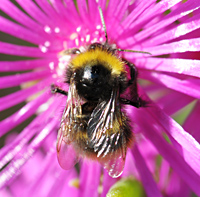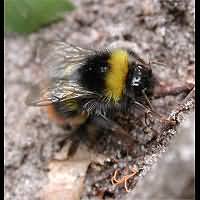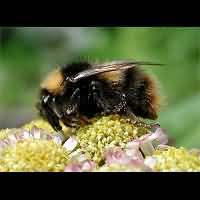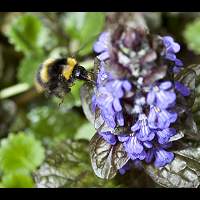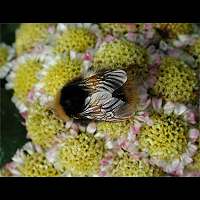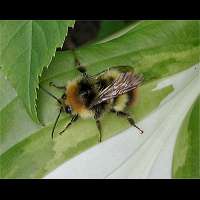[All pictures of garden wildlife on this page are thumbnails. Click on any thumbnail for a large format to be displayed.]
Early Bumblebee / Bombus pratorum
Another smaller species seen in gardens frequently is the Early Bumblebee. The queen, reaching a length of some 17 mm and having a wingspan of up to 32 mm. is about the same size as the Common Carder Bee's. The workers and the males are just a tiny bit smaller than those of the Common Carder Bee. The front part of the thorax is covered with yellow hairs, even though the thorax may be covered with yellow hairs entirely, especially in males. The hairs however are always brightly yellow and do not tend to be brown as in the case of the Common Carder Bee. Often the first part of the abdomen is yellow as well, but the yellow hairs may be absent here. The tail is strikingly orange. In older specimens the colouring may be less striking as the hairs tend to become dirty white, as in many other species. At times it is an awkward job to identify worn out animals! Due to its small size and colouring the Early Bumblebee often is easily identifiable. And even more so because there are not many look-a-likes around. In the Alps however several mountain species do look like the Early Bumblebee, so be careful once over there. The species is very common all over Europe. The tongue is shorter than the Brown Carder Bee's and therefore the animal used to be called Pyrobombus pratorum scientifically.
Despite the name the Early Bumblebee is not the species seen most early. The much bigger Earth Bumblebee sometimes flies by the end of February, while most Early Bumblebees start looking for a good place to nest in the middle of March. A nest may contain any number, usually from 50 to some 120 individuals. Like the common Carder Bee the Early Bumblebee is not very choosy when it comes to nesting spots: old and abondoned mice nests will do, but so will heaps of dead grass, old bird nests, stables and even nesting boxes. When it comes to flowers this is your universal pollinator: well over 140 flowers are being visited, quite randomly, including many exotic garden flowers. The species can be found almost everywhere: meadows, gardens, parks and the deges of forests, though it will never nest deep inside woodlands. This is a very common species all over the British Isles.
The animal in the bottom picture is a drone (male).
Despite the name the Early Bumblebee is not the species seen most early. The much bigger Earth Bumblebee sometimes flies by the end of February, while most Early Bumblebees start looking for a good place to nest in the middle of March. A nest may contain any number, usually from 50 to some 120 individuals. Like the common Carder Bee the Early Bumblebee is not very choosy when it comes to nesting spots: old and abondoned mice nests will do, but so will heaps of dead grass, old bird nests, stables and even nesting boxes. When it comes to flowers this is your universal pollinator: well over 140 flowers are being visited, quite randomly, including many exotic garden flowers. The species can be found almost everywhere: meadows, gardens, parks and the deges of forests, though it will never nest deep inside woodlands. This is a very common species all over the British Isles.
The animal in the bottom picture is a drone (male).

© Copyright 1998-2024 gardensafari.net (Hania Berdys)

 English / engels
English / engels  Dutch / nederlands
Dutch / nederlands